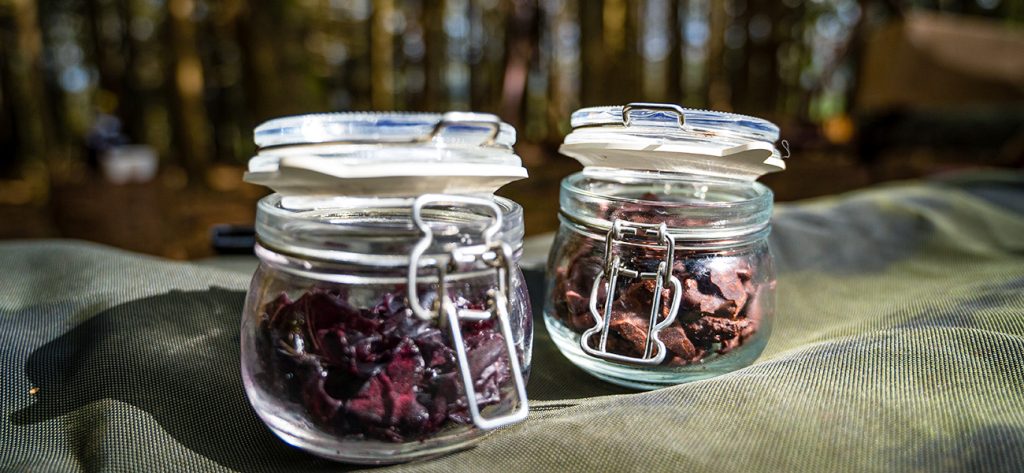What can I do with Hawthorn Berries?
The fruits are easy to identify and collect in large quantities and can be used to make fruit leathers (another name for a fruit roll-up),…

20th September 2023
Wood ear (Auricularia auricula judae) is an ear shaped fungus with a jelly sweet like consistency which grows on dead or dying Elder trees. Given the right weather conditions, it can be found almost year round and is easy to gather and dry out at home in preparation for the recipe below. The best ways to dry out mushrooms which you have gathered is either in a dehydrator, oven on a low heat with the door ajar to allow moisture to escape, or by hanging them in a dry and warm place in a mesh bag. We often hang ours near the wood burner and give them a shake every couple of days to ensure that nothing is sticking together and encapsulating moisture.
This mushroom can be used in stocks, dried and ground down into a powder, or cooked into casseroles, stir fry’s and soups. Our favourite use for them is to create what we affectionately call an alcoholic fungal turkish delight, inspired by John Wright.
This is the recipe that we always share when talking about wood / jelly ear ( Auricularia auricula judae) It is perfect for stocking fillers or small handmade gifts and will always raise an eyebrow or two. When prepping your wood ear for drying, be sure to remove any bits of bark, twig, moss and other detritus as they will be more firmly attached after they have dried out.
For the alcoholic chocolate covered version
For the non-alcoholic version
Take your dried wood/jelly ear and put enough in a jar to half fill it.
Fill the jar to cover the fungi with alcohol/fruit juice of your choice and leave for 2 days. If you forget about it soaking in alcohol for a while, don’t worry. However if it is soaking in fruit juice then it is best to keep in the fridge if you won’t be proceeding to the next step after a couple of days (or it will go ‘off’ or start to grow mould)
If chocolate coating
Melt chocolate in a bain marie or carefully in the microwave so as not to burn it.
Whilst chocolate is melting, fish out your soaked fungi and place on paper towel and pat dry to remove excess liquid.
With a skewer or fork, pick up pieces of wood ear one by one and dip into the molten chocolate, allow excess to drip back into the bowl and place the coated fungi onto a piece of greaseproof paper on a flat surface. Repeat with the rest of your pieces ensuring that they are separate on the greaseproof paper and then leave for the chocolate to set.
These store best in an airtight container (such as a jar) in a cool, dark place. If left in the fridge they tend to develop condensation.
For the non-chocolate coated
There are two options here, either coat in icing sugar by patting dry with paper towel and then rolling in icing sugar on a plate or shallow bowl. Or – shake off excess liquid, then roll in a mixture of sugar and granulated citric acid on a plate or shallow bowl. These will be like a more natural form of haribo tangfastic!
The alcohol infused wood ear coated in chocolate make a great gift and keep well for a fairly long time, we’re talking a couple of months. However if you have infused with fruit juice they will need storing in the fridge as they will be more likely to develop additional (and unwanted) mould/fungi!
If you have more alcohol infused fungi than you want to use at that time, simply leave the excess in the jar until you next need it.
With over a decade of experience working outside in the UK doing everything from dry stone walling to tree planting and carrying out wildlife surveys. Amy is our resident ecologist and wild food enthusiast, and also works as a consultant for various brands and wildlife organisations. Amy lives in North Wales.
A Life More Wild is the philosophy which underpins everything we do.
It encompasses practical skills, personal development, community learning and a journey to live more intentionally.
The fruits are easy to identify and collect in large quantities and can be used to make fruit leathers (another name for a fruit roll-up),…
North Wales is a fantastic place to look for fungi, with a wide range of habitats and ideal climate. If you’ve been out to a…
This mushroom can be used in stocks, dried and ground down into a powder, or cooked into casseroles, stir fry’s and soups. Our favourite use…
Sloes are ripe before the first frosts these days, but you can use a freezer to imitate the affect of a frost and have some…
